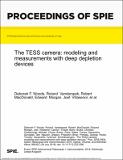| dc.contributor.author | Woods, Deborah F. | |
| dc.contributor.author | Vanderspek, Roland K | |
| dc.contributor.author | MacDonald, Robert E. | |
| dc.contributor.author | Morgan, Edward H | |
| dc.contributor.author | Villasenor, Jesus Noel Samonte | |
| dc.contributor.author | Thayer, Carolyn T. | |
| dc.contributor.author | Burke, Barry E. | |
| dc.contributor.author | Chesbrough, Christian D. | |
| dc.contributor.author | Chrisp, Michael P. | |
| dc.contributor.author | Clark, Kristin E. | |
| dc.contributor.author | Gonzales, Alexandria | |
| dc.contributor.author | Nguyen, Tam | |
| dc.contributor.author | Prigozhin, Gregory | |
| dc.contributor.author | Primeau, Brian | |
| dc.contributor.author | Sauerwein, Timothy A | |
| dc.contributor.author | Furesz, Gabor | |
| dc.contributor.author | Ricker, George R | |
| dc.contributor.author | Suntharalingam, Vyshnavi | |
| dc.date.accessioned | 2018-05-11T15:04:57Z | |
| dc.date.available | 2018-05-11T15:04:57Z | |
| dc.date.issued | 2016-06 | |
| dc.identifier.uri | http://hdl.handle.net/1721.1/115318 | |
| dc.description.abstract | The Transiting Exoplanet Survey Satellite, a NASA Explorer-class mission in development, will discover planets around nearby stars, most notably Earth-like planets with potential for follow up characterization. The all-sky survey requires a suite of four wide field-of-view cameras with sensitivity across a broad spectrum. Deep depletion CCDs with a silicon layer of 100 μm thickness serve as the camera detectors, providing enhanced performance in the red wavelengths for sensitivity to cooler stars. The performance of the camera is critical for the mission objectives, with both the optical system and the CCD detectors contributing to the realized image quality. Expectations for image quality are studied using a combination of optical ray tracing in Zemax and simulations in Matlab to account for the interaction of the incoming photons with the 100 μm silicon layer. The simulations include a probabilistic model to determine the depth of travel in the silicon before the photons are converted to photo-electrons, and a Monte Carlo approach to charge diffusion. The charge diffusion model varies with the remaining depth for the photo-electron to traverse and the strength of the intermediate electric field. The simulations are compared with laboratory measurements acquired by an engineering unit camera with the TESS optical design and deep depletion CCDs. In this paper we describe the performance simulations and the corresponding measurements taken with the engineering unit camera, and discuss where the models agree well in predicted trends and where there are differences compared to observations. | en_US |
| dc.publisher | SPIE | en_US |
| dc.relation.isversionof | http://dx.doi.org/10.1117/12.2231296 | en_US |
| dc.rights | Article is made available in accordance with the publisher's policy and may be subject to US copyright law. Please refer to the publisher's site for terms of use. | en_US |
| dc.source | SPIE | en_US |
| dc.title | The TESS camera: modeling and measurements with deep depletion devices | en_US |
| dc.type | Article | en_US |
| dc.identifier.citation | Woods, Deborah F., et al. "The TESS Camera: Modeling and Measurements with Deep Depletion Devices." Proceedings Volume 9904, Space Telescopes and Instrumentation 2016: Optical, Infrared, and Millimeter Wave, 26 June - 1 July, 2016, Edinburgh, United Kingdom, edited by Howard A. MacEwen et al., 2016, p. 99042C. © 2016 SPIE | en_US |
| dc.contributor.department | Lincoln Laboratory | en_US |
| dc.contributor.department | Massachusetts Institute of Technology. Department of Earth, Atmospheric, and Planetary Sciences | en_US |
| dc.contributor.department | MIT Kavli Institute for Astrophysics and Space Research | en_US |
| dc.contributor.mitauthor | Woods, Deborah F. | |
| dc.contributor.mitauthor | Vanderspek, Roland K | |
| dc.contributor.mitauthor | MacDonald, Robert E. | |
| dc.contributor.mitauthor | Morgan, Edward H | |
| dc.contributor.mitauthor | Villasenor, Jesus Noel Samonte | |
| dc.contributor.mitauthor | Thayer, Carolyn T. | |
| dc.contributor.mitauthor | Burke, Barry E. | |
| dc.contributor.mitauthor | Chesbrough, Christian D. | |
| dc.contributor.mitauthor | Chrisp, Michael P. | |
| dc.contributor.mitauthor | Clark, Kristin E. | |
| dc.contributor.mitauthor | Gonzales, Alexandria | |
| dc.contributor.mitauthor | Nguyen, Tam | |
| dc.contributor.mitauthor | Prigozhin, Gregory | |
| dc.contributor.mitauthor | Primeau, Brian | |
| dc.contributor.mitauthor | Sauerwein, Timothy A | |
| dc.contributor.mitauthor | Furesz, Gabor | |
| dc.contributor.mitauthor | Ricker, George R | |
| dc.contributor.mitauthor | Suntharalingam, Vyshnavi | |
| dc.relation.journal | Proceedings Volume 9904, Space Telescopes and Instrumentation 2016: Optical, Infrared, and Millimeter Wave | en_US |
| dc.eprint.version | Final published version | en_US |
| dc.type.uri | http://purl.org/eprint/type/ConferencePaper | en_US |
| eprint.status | http://purl.org/eprint/status/NonPeerReviewed | en_US |
| dc.date.updated | 2018-03-16T19:01:18Z | |
| dspace.orderedauthors | Woods, Deborah F.; Vanderspek, Roland; MacDonald, Robert; Morgan, Edward; Villasenor, Joel; Thayer, Carolyn; Burke, Barry; Chesbrough, Christian; Chrisp, Michael; Clark, Kristin; Furesz, Gabor; Gonzales, Alexandria; Nguyen, Tam; Prigozhin, Gregory; Primeau, Brian; Ricker, George; Sauerwein, Timothy; Suntharalingam, Vyshnavi | en_US |
| dspace.embargo.terms | N | en_US |
| dc.identifier.orcid | https://orcid.org/0000-0001-7149-2792 | |
| dc.identifier.orcid | https://orcid.org/0000-0003-2058-6662 | |
| mit.license | PUBLISHER_POLICY | en_US |
